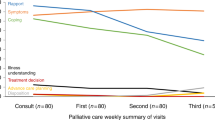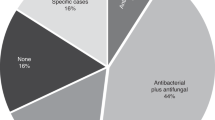Abstract
Previous studies have shown an equivalent pharmacokinetic profile between four-times-daily (4QD) and once-daily (QD) administration of intra-venous (IV) BU, without increased toxicity. We assess the impact of a switch in IV BU from a 4QD to a QD schedule, in terms of health-care organization, staff working conditions, quality of care dispensed and perceived patient comfort. Clinicians, nurses and pharmacists from nine allogeneic transplantation units in five European countries were interviewed face to face. Overall perception of QD versus 4QD BU was very positive. Both administration schemes were evaluated to be equally efficaciousZ. QD BU was perceived to be safer and more convenient. Clinicians and nurses perceived that patient comfort was improved, due to fewer complications associated with repeated infusions, and avoiding night infusions associated with stress, anxiety and decreased quality of sleep. Switching from 4QD to QD BU had a significant impact on health-care organization, with a better integration in the overall management and usual timelines in the pharmacies and transplantation units. Time spent to prepare and administer BU was significantly reduced, leading to potential financial savings that merit further assessment and would be of particular interest in the current economic climate.
This is a preview of subscription content, access via your institution
Access options
Subscribe to this journal
Receive 12 print issues and online access
$259.00 per year
only $21.58 per issue
Buy this article
- Purchase on Springer Link
- Instant access to full article PDF
Prices may be subject to local taxes which are calculated during checkout
Similar content being viewed by others
References
Sobecks RM, Rybicki L, Yurch M, Kalaycio M, Dean R, Andresen S et al. Intravenous compared with oral busulfan as preparation for allogeneic hematopoietic progenitor cell transplantation for AML and MDS. Bone Marrow Transplant 2012; 47: 633–638.
Leger F, Nguyen L, Puozzo C . Exposure equivalence between IV (0.8 mg/kg) and oral (1 mg/kg) busulfan in adult patients. Eur J Clin Pharmacol 2009; 65: 903–911.
Russell JA, Tran HT, Quinlan D, Chaudhry A, Duggan P, Brown C et al. Once-daily intravenous busulfan given with fludarabine as conditioning for allogeneic stem cell transplantation: study of pharmacokinetics and early clinical outcomes. Biol Blood Marrow Transplant 2002; 8: 468–476.
Kashyap A, Wingard J, Cagnoni P, Roy J, Tarantolo S, Hu W et al. Intravenous versus oral busulfan as part of a busulfan/cyclophosphamide preparative regimen for allogeneic hematopoietic stem cell transplantation: decreased incidence of hepatic venoocclusive disease (HVOD), HVOD-related mortality, and overall 100-day mortality. Biol Blood Marrow Transplant 2002; 8: 493–500.
Dean RM, Pohlman B, Sweetenham JW, Sobecks RM, Kalaycio ME, Smith SD et al. Superior survival after replacing oral with intravenous busulfan in autologous stem cell transplantation for non-Hodgkin lymphoma with busulfan, cyclophosphamide and etoposide. Br J Haematol 2010; 148: 226–234.
Bredeson CN, Zhang MJ, Agovi MA, Bacigalupo A, Bahlis NJ, Ballen K et al. Outcomes following HSCT using fludarabine, busulfan, and thymoglobulin: a matched comparison to allogeneic transplants conditioned with busulfan and cyclophosphamide. Biol Blood Marrow Transplant 2008; 14: 993–1003.
Grochow LB, Jones RJ, Brundrett RB, Braine HG, Chen TL, Saral R et al. Pharmacokinetics of busulfan: correlation with veno-occlusive disease in patients undergoing bone marrow transplantation. Cancer Chemother Pharmacol 1989; 25: 55–61.
Ryu SG, Lee JH, Choi SJ, Lee JH, Lee YS, Seol M et al. Randomized comparison of four-times-daily versus once-daily intravenous busulfan in conditioning therapy for hematopoietic cell transplantation. Biol Blood Marrow Transplant 2007; 13: 1095–1105.
Madden T, de Lima M, Thapar N, Nguyen J, Roberson S, Couriel D et al. Pharmacokinetics of once-daily IV busulfan as part of pretransplantation preparative regimens: a comparison with an every 6-hour dosing schedule. Biol Blood Marrow Transplant 2007; 13: 56–64.
de Lima M, Couriel D, Thall PF, Wang X, Madden T, Jones R et al. Once-daily intravenous busulfan and fludarabine: clinical and pharmacokinetic results of a myeloablative, reduced-toxicity conditioning regimen for allogeneic stem cell transplantation in AML and MDS. Blood 2004; 104: 857–864.
Solomon SR, Matthews RH, Barreras AM, Bashey A, Manion KL, McNatt K et al. Outpatient myeloablative allo-SCT: a comprehensive approach yields decreased hospital utilization and low TRM. Bone Marrow Transplant 2010; 45: 468–475.
Subira M, Sureda A, Ancin I, Martino R, Altes A, Brunet S et al. Allogeneic stem cell transplantation with reduced-intensity conditioning is potentially feasible as an outpatient procedure. Bone Marrow Transplant 2003; 32: 869–872.
Passweg JR, Baldomero H, Gratwohl A, Bregni M, Cesaro S, Dreger P et al. The EBMT activity survey: 1990-2010. Bone Marrow Transplant 2012; 47: 906–923.
Acknowledgements
The authors wish to thank all participating pharmacists and nurses for their contribution to this study: Pharmacists: Isabelle Madelaine, Elżbieta Bartczak, Anna Farriols, Emanuela D'Angelo, Emmanuelle Fougereau, Norberta Sánchez, Jens Dettmann, Antje Völsgen, Hans Joachim Volk, Raffaella La Russa. Nurses: Valérie Ducollet, Katarzyna Białkowska, Mercedes Valentí, Daniela Di Nicola, Laurence Caymaris, Pilar Alonso, Veronica Molinari, Kathrin Kroggel, Christina Heinz. Special thanks to Professor Gérard Socié for his review and expertise.
Author information
Authors and Affiliations
Corresponding author
Ethics declarations
Competing interests
A Xhaard received honoraria from Pierre-Fabre for writing this manuscript.
Additional information
Supplementary Information accompanies the paper on Bone Marrow Transplantation website
Supplementary information
Rights and permissions
About this article
Cite this article
Xhaard, A., Rzepecki, P., Valcarcel, D. et al. Optimization of health-care organization and perceived improvement of patient comfort by switching from intra-venous BU four-times-daily infusions to a once-daily administration scheme in adult hematopoietic stem cell recipients. Bone Marrow Transplant 49, 509–512 (2014). https://doi.org/10.1038/bmt.2013.220
Received:
Revised:
Accepted:
Published:
Issue Date:
DOI: https://doi.org/10.1038/bmt.2013.220



